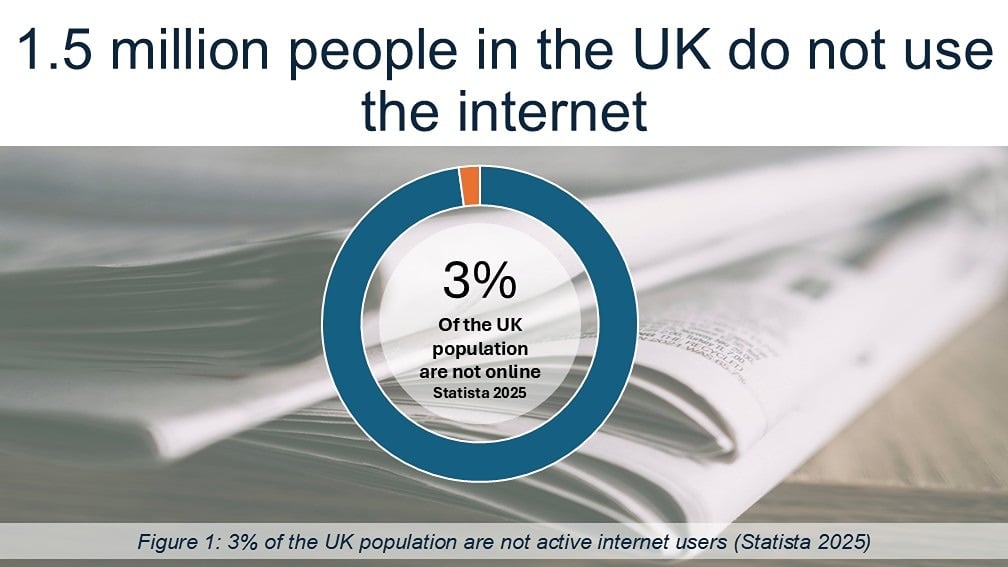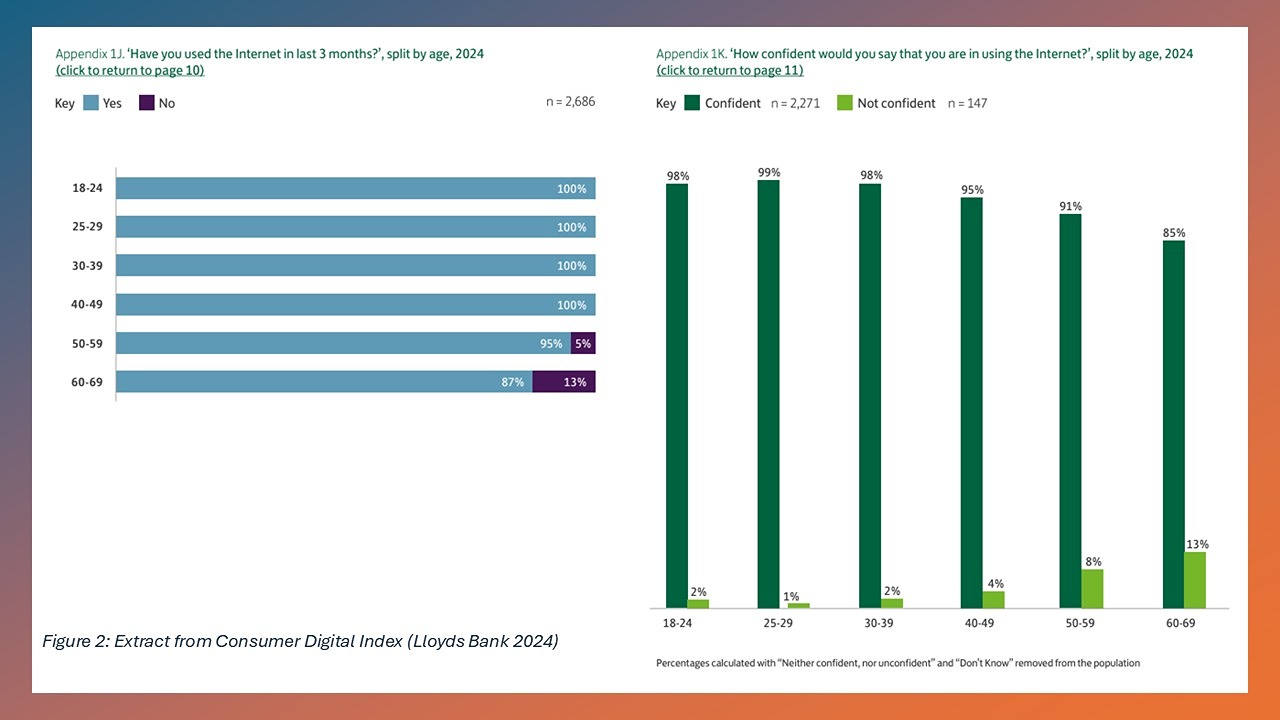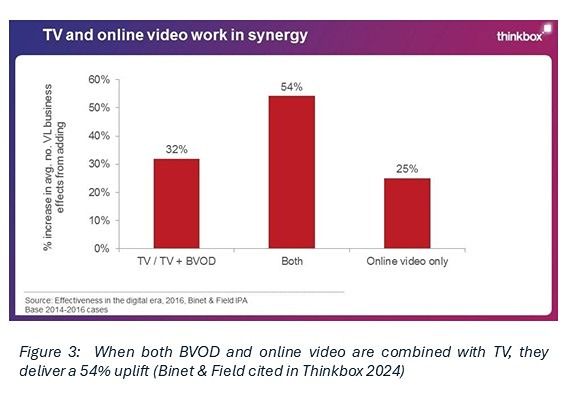Should Media Planners Ignore the 3% of UK Consumers Who Aren’t Online?

Hello! This post is the the third instalment of a six-part series I’m creating as part of the Global Media Planning module for my Masters in Marketing and Digital Communications. Each instalment will tackle a different question from the assignment brief, and I’ll be sharing my progress along the way. The final assignment submission will bring everything together by focusing on three of the most important questions. Whether you’re interested in global media planning or just curious about the behind-the-scenes of a master’s assignment, I hope you find these insights useful. Thanks for following along!

Over 1.5 million UK adults remain offline (Statista 2025), accounting for 3% of the population, as shown in Figure 1. A detail that might seem insignificant in today’s programmatic media landscape. Yet, this minority challenges a core assumption of modern marketing: that digital access is universal. Should media planners simply write off those who are not online? This post, part of my Global Media Planning series, interrogates that question, urging marketers to rethink what efficiency really means. By exploring the commercial and ethical risks of digital-only strategies, it makes the case for integrated offline-online approaches that drive both business results and genuine inclusion.
The Risks of Digital-Only Assumptions
Digital-first media strategies thrive on scalable reach, precise targeting, and measurable ROI, yet efficiency must not be mistaken for effectiveness. The 3% offline population is heterogeneous, disproportionately comprising older adults, disabled people, low-income households, and rural residents (Lloyds Bank 2023). These segments often carry significant lifetime value, especially in sectors like healthcare, financial services, and utilities, challenging the idea that ignoring them is a minor sacrifice. Figure 2 shows the UK population broken down by usage and confidence.

The Case For Traditional Media
Lumen Research (2024) demonstrates that traditional media delivers three times the attention per impression compared to digital display ads, with superior brand recall and engagement, while digital-only contexts suffer a 20% drop in advertising attention span, underlining the risk of excluding offline channels. Recent findings reinforce that integrating traditional media with digital channels does more than simply reach the 3% of UK adults who remain offline; it also enhances the overall effectiveness of digital campaigns. For example, combining traditional TV with broadcaster video on demand (BVOD) and other online video formats delivers a 54% uplift in advertising effectiveness, shown in Figure 3 (Thinkbox 2024), strengthening emotional engagement and brand recall, key drivers of long-term growth.
By addressing offline audiences with channels like TV, print, direct mail, and out-of-home, media planners not only ensure inclusivity but also reinforce brand messaging across all touchpoints, creating a virtuous cycle where offline exposure builds familiarity and trust that supports higher engagement and conversion rates for digital efforts. Rather than viewing offline and online as opposites, planners should orchestrate multi-channel strategies to harness their complementary strengths, ensuring that no audience is left behind and that campaigns achieve maximum impact and ethical reach.

Case Study: COVID-19 - A Lesson for Everyday Advertising
The UK Government’s response during the COVID-19 pandemic provides a powerful case study for media planners (Aiken 2020). Faced with a national emergency, communication planners didn’t rely solely on digital channels; instead, they deployed a comprehensive, integrated strategy using both trusted offline platforms, such as TV, radio, and direct mail; and digital media to ensure critical messages reached every segment of the population. This approach wasn’t just a matter of tradition or compliance, but a recognition that when communication really matters, no audience can be left behind. If such a strategy is considered essential for public health and safety, why should the standards be any lower for brand advertising? After all, the commercial stakes, brand trust, customer loyalty, and long-term growth, also depend on reaching and resonating with all potential consumers, not just the digitally connected majority.
For media planners, the lesson is clear: the imperative to integrate online and offline channels is not unique to emergencies. It is a best practice for any campaign that aspires to be effective, inclusive, and future proof. By placing the same importance on offline audiences in advertising as we do in crises, brands can maximise reach, build deeper trust, and ensure their messages are seen and acted upon by everyone who matters.
Conclusion: Inclusion is Both Strategy and Responsibility
The 3% of UK adults who remain offline are not a rounding error, but a strategic and ethical test for modern media planners. While digital channels offer efficiency and scale, true effectiveness comes from reaching all relevant audiences with meaningful, attention-grabbing messages. Planners must move beyond what is easy to measure and embrace what is meaningful to influence, adopting integrated strategies that combine the best of both digital and traditional media. This means investing in better segmentation, developing new metrics for cross-channel impact, and fostering a culture of innovation and inclusion.
Ultimately, the most successful brands will be those that see inclusion not as a compliance issue, but as a driver of long-term brand growth and societal value.
Thanks so much for reading. I’d really love to hear what you think, whether you agree, disagree, or just want to chat about media planning (or assignment writing!). Feel free to comment on my LinkedIn posts (where I’ll be sharing each part) or drop me an email. Your feedback will be a huge help as I decide which three posts to polish up for my final assignment. Looking forward to connecting!
References
Aiken, A. (2020) COVID-19 Communications Advisory Panel Report. Government Communication Service. Available at: https://gcs.civilservice.gov.uk/wp-content/uploads/2020/10/COVID-19_Communications_Advisory_Panel_Report.pdf (Accessed: 27 June 2025).
Lloyds Bank, UK Consumer Digital Index 2024 (Consumer Digital Index), November 2023. Available at: https://www.lloydsbank.com/consumer-digital-index.html (Accessed: 27 June 2025).
Lumen Research, 2024. Survey: The Attention Metrics Landscape in 2024. Available at: https://lumen-research.com/blog/survey-the-attention-metrics-landscape-in-2024/ [Accessed 27 June 2025].
Statista, Internet usage in the UK (Statista topic 3246), 2025. Available at: https://www.statista.com/topics/3246/internet-usage-in-the-uk/ (Accessed: 27 June 2025).
Thinkbox (2024) Marketing Effectiveness in the Digital Era: Media in Focus. Available at: https://www.thinkbox.tv/research/thinkbox-research/marketing-effectiveness-in-the-digital-era-media-in-focus (Accessed: 27 June 2025).
Bibliograpy
Note: This was a really interesting post to research – the limitations of the assignment was 700 words, and there’s a lot of good stuff that didn’t make the final edit. I have included the full bibliography all of which helped to research the post
Dhingra, N., Mathew, J. & Narayanan, S., 2023. The attention equation: Winning the right battles for consumer attention. McKinsey & Company. Available at: https://www.mckinsey.com/industries/technology-media-and-telecommunications/our-insights/the-attention-equation-winning-the-right-battles-for-consumer-attention [Accessed 27 June 2025].
Ellis, K., Goggin, G. & Dau, D., 2024. Communication and Disability in the COVID-19 Pandemic. In: M. Lewis, E. Govender & K. Holland, eds. Communicating COVID-19. Cham: Palgrave Macmillan, pp. [page range if known]. Available at: https://doi.org/10.1007/978-3-031-41237-0_11 [Accessed 27 June 2025].
House of Lords Library, Digital exclusion in the UK: Communications and Digital Committee report, 30 January 2024. Available at: https://lordslibrary.parliament.uk/digital-exclusion-in-the-uk-communications-and-digital-committee-report/ (Accessed: 27 June 2025).
MediaShotz (2025) AA/WARC Expenditure Report Q4 2024: Industry reactions. MediaShotz. Available at: https://mediashotz.co.uk/aa-warc-expenditure-report-q4-2024-industry-reactions/ (Accessed: 27 June 2025).
Obia, V. (2022) ‘The costs of connection: how data is colonizing human life and appropriating it for capitalism: by Nick Couldry and Ulises A. Mejias, Stanford, Stanford University Press, 2019, 352 pp., £22.92 (paperback), ISBN: 9781503609747’, Information, Communication & Society, 26(9), pp. 1908–1910. doi: 10.1080/1369118X.2022.2062254.
Ofcom (2024) Adults’ media use and attitudes report 2024. Available at: https://www.ofcom.org.uk/siteassets/resources/documents/research-and-data/media-literacy-research/adults/adults-media-use-and-attitudes-2024/adults-media-use-and-attitudes-report-2024.pdf?v=321395 (Accessed: 27 June 2025).
Statista (2025) Advertising spending in the UK by media. Statista. Available at: https://www.statista.com/statistics/262492/advertising-spending-in-the-uk-by-media/ (Accessed: 27 June 2025).
Figures
About the author
I am currently studying for a master’s in Marketing and Digital Communications at Falmouth University. This series on Global Media Planning is part of an academic assignment, so if you’ve ever wondered what university assignments in this field look like, you may find these posts offer a useful insight. I invite you to follow along for future instalments and would love to hear your thoughts or comments, please feel free to share your perspectives on LinkedIn where I am sharing the series.

Comments